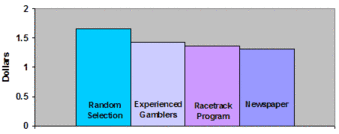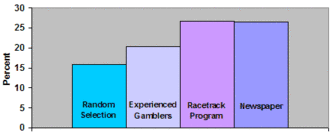With last weekend’s Kentucky Derby signaling the beginning of the prestigious Triple Crown events, it seems fitting to focus this week’s WAGER on pari-mutuel gambling. The Derby winner, Funny Cide, was a 12:1 long shot that edged out the horse heavily favored to win. Conventional wisdom has it that many gamblers think they can increase their winnings by researching the horses and tracks to make skillful picks. Ladouceur, Giroux and Jacques (1998) conducted a series of experiments to test this assumption – and, like this year’s Derby upset – their findings might surprise you.
To determine the impact of knowledge and skill on bet outcome, Ladouceur et al. compared the outcomes of four betting strategies: (1) random selection, (2) experienced gamblers, (3) racetrack picks, and (4) newspaper picks. To assess experienced gambler betting, a graduate student research assistant, who was working as a runner in a clubhouse at the Quebec City racetrack, recorded her clients’ bets for one month. All her clients had attended the track at least weekly over the past year. During the 1 month study period, these gamblers placed a total of 1,170 win, place and show bets (i.e., that the horse will finish in first, second or third place). For each of the races on which the gamblers placed bets, the researchers recorded the horses selected by the racetrack program and by the newspaper. A $2 simulated bet was made for each race based on these choices. The researchers also simulated a $2 bet for a horse selected from a table of random numbers. Researchers recorded the frequency of picking the winning horse and the amount of money returned on the $2 bet for each of the four strategies.
As Figure 1 illustrates, the horses selected in the racetrack program and newspaper won significantly more often than the horses selected by either the experienced gamblers or by random selection (Chi2(N=1,413)=16.87, p<.01). The experienced gamblers did not perform statistically better than random selection (p=.08).
Figure 1. Results of Various Methods Used in Picking the Winning Horse
Overall, all betting methods resulted in a net loss of money (Figure 2). In contrast to the significant strategy difference for wins, an ANOVA showed no significant differences in the amount of money returned for a $2 bet by betting strategy. This pattern arises because of the structure of pari-mutuel gambling. Although the published choices were more accurate, they reflected favored horses and did not generate high returns. Winning horses chosen by random selection were more likely to be long-shots and thus yielded larger returns.
Figure 2. Average Amount of Money Returned on $2 Bet

Although many gamblers view pari-mutuel betting as a game of skill and strategy, the results from this study suggest that these elements have little to do with the outcome. Experienced gamblers did no better than random chance. There are, however, several caveats. First, the simulation protocol did not accurately reflect the strategies normally used by gamblers at the racetrack. For example, the study did not record the amount of money wagered on each race by the gamblers at the track. The size of the bet is influenced by the confidence the gambler has in the horse winning and how much the horse will pay if it wins. The simulation made a flat $2 bet on every race; the overall amount of money returned may be different when the size of the bet is allowed to vary between races. Additionally, although we can surmise that the experienced gamblers all came from a small pool of bettors – they all frequented the same track and were assigned to the same runner – we do not know how many gamblers actually make up the experienced gambler group. Further, nothing is known about the knowledge or skill level of these gamblers, merely that they attend the races regularly. Hence, skillful and unskillful gamblers could have been combined in one group. Finally, while the predictions published in the newspaper and racetrack program were made by purported experts, the predictions were applied without regard for strategy (i.e., which races warranted bets was not considered). A combination of different and perhaps higher levels of skill and strategy might yield different outcomes.
Nevertheless, this study indicates that the structure of the pari-mutuel is such that even experts might fail to turn a profit in the long run. This analysis might be helpful in correcting cognitive misconceptions held by problem gamblers about the influence of skill on betting outcomes and their tendency to overestimate the extent of their betting skill. Given the inevitable net loss over time, any money spent on the track might be best viewed as an “entertainment cost.”
Comments on this article can be addressed to Rachel Kidman.
References
Ladoucer, R., Giroux, I., Jacques, C. (1998) Winning on the horses: How much strategy and knowledge are needed? Journal of Psychology, 132(2), 133-142.





